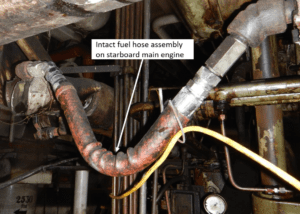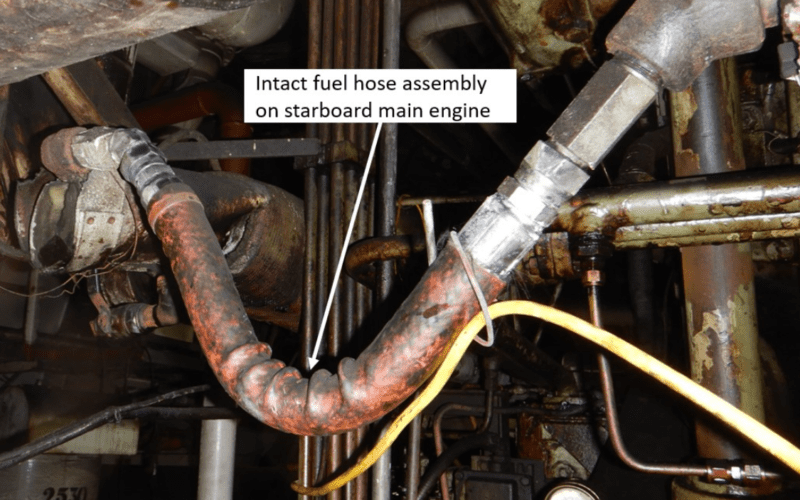(QUEBEC CITY) — The Transportation Safety Board of Canada (TSB) has released its investigation report (M19C0403) regarding the 2019 fire aboard the bulk carrier Tecumseh near Windsor, Ontario. The report raises a board safety concern regarding firefighting resources at some Canadian harbors and ports.
On Dec. 15, 2019, a fire ignited in the engine room of Tecumseh while transiting the Detroit River off Windsor, Ontario, with16 crewmembers on board. The crew attempted to extinguish the fire with the carbon dioxide (CO2) fixed fire suppression system.

The investigation found that the onboard fire originated following the failure of a flexible fuel hose assembly supplying fuel to the port main engine. Approximately three hours after the fire suppression system was activated, two crewmembers entered the engine room to determine if the fire was still spreading. This re-entry allowed fresh air to enter the engine room, which most likely re-ignited the fire.
In the early hours of Dec. 16, the vessel was towed to the Port of Windsor for firefighting assistance. However, the onshore resources were not trained in marine firefighting and therefore were not able to provide onboard assistance. As a consequence, these responders remained on shore providing shore-based boundary cooling while awaiting the arrivial of marine-trained firefighters, who arrived approximately two hours later. The fire was subsequently extinguished later that same day.
In 1996, the board issued a recommendation (M96-07) for Transport Canada, in collaboration with ports and harbor authorities, to take measures to ensure that shore-based fire brigades expected to support onboard firefighting receive appropriate training. Given subsequent changes in responsibility for the operation of ports in Canada, the recommendation was closed in 2016 with an assessment of “Satisfactory in Part,” noting that the safety deficiencies remained in some ports.
This investigation identified similar issues to those highlighted in M96-07. As such, the board is concerned that some Canadian ports and harbor authorities may lack the proper equipment, training and resources to respond effectively to shipboard fires occurring within their jurisdiction, which could result in fires that endanger crews, the general public, property and the environment.
The investigation also identified a number of shortcomings within the operator’s safety management system with regard to fire response, including that the fire training manual on board was not specific to the vessel, and so vessel-specific information was not available for use in training on actual equipment on board, such as the CO2 system; and there was no emergency preparedness plan on board to guide the crew in the fire response actions, such as when to close the ventilation flaps and dampers.
The investigation also found that the operator’s safety management system had no guidance with respect to documentation, testing, or inspection and maintenance schedules to ensure that the fuel hose assemblies on the main engines were of adequate integrity and remained in working condition. Although a classification survey had been conducted on the vessel 24 days prior to the occurrence, the survey had not identified any issues with the fuel hose assemblies despite a class rule requiring that these assemblies be prototype-tested. The investigation also noted that there were several regulatory noncompliances on board the vessel, including those related to structural integrity.
Following this occurrence, vessel owner Lower Lakes Towing Ltd. reminded masters and senior officers that in the absence of exceptional circumstances, no attempt to re-enter the engine room or other action that could compromise the airtightness of the sealed room should be made once CO2 is released, until after the temperature drops below the auto-ignition point. Regarding maintenance, the company also changed the software used for maintenance planning and tracking. It also appointed third-party auditors for each vessel to look at the planned maintenance system, policies and procedures, regulatory and environmental procedures, and training requirements.
– Transportation Safety Board of Canada

